[Updated December 14, 2018]
DOG BARKING: OVERVIEW
1. Determine what kind of barking your dog is doing, and take appropriate measures to modify the behavior.
2. Remember that exercise is an important part of almost all behavior modification programs, including barking.
3. Don’t yell at your dog, no matter how much you want to! It doesn’t teach her anything.
4. If a dog in your neighborhood is barking excessively, offer to help your neighbor understand how to change her dog’s behavior.
There’s a lot of talk these days about the fact that dogs are primarily body language communicators. It’s true, they are. But as anyone who’s spent time with them knows, dogs also have a pretty well-developed ability to express themselves vocally. Dogs bark. Some bark more, some bark less, and a few don’t bark at all, but most dogs bark at least some of the time.
The Reasons Dogs Bark
As the owner of four dogs, two of whom are very vocal, with a third quite willing to express himself on occasion, I can testify to the domestic dog’s ability to speak. Interestingly, while wild puppies bark, wild adult dogs rarely do, at least not to the degree our canine companions do.
Canine genetics plays a large role here, of course. Over the millennia that we humans have been selectively breeding dogs, we’ve purposely bred some dogs to be loud, others to be quiet.

At the “more” end of the continuum, the scent hounds are programmed to give voice to announce the presence of their quarry. Thus Beagles, Coonhounds, Foxhounds, and others in this group are quite vocal – although they do tend to bay rather than yap. Most of the herding breeds are easily incited to bark. Skilled at telling a recalcitrant sheep or cow to back off, these Type-A workaholic dogs also delight in playing the role of noisy fun police. Many of the toy breeds also have a well-deserved reputation for barkiness as do the terriers.
In the “less-barking” category, the guarding breeds tend to reserve their formidable vocalizing for serious provocation. Sight hounds also lean toward the quiet side, preferring to chase their quarry rather than bark at it. Then, of course, there’s the Basenji -a somewhat primitive African breed of dog who doesn’t bark – but he sure can scream!
Another reason wild dogs bark less than our own furry family members is that they are less likely to be subjected to environments that encourage barking, such as fenced yards with potential prey objects (skateboards, joggers, bicycles) speeding tantalizingly past just out of reach; or humans who inadvertently – or intentionally – reinforce barking.
Different Kinds of Dog Barks
Dogs bark for various reasons. If you want to modify your dog’s barking behavior (either decrease it or increase it) it’s helpful to know what kind of barking your dog is doing, how the behavior is being reinforced, and what to do about it.
Alert/alarm barking
This is the dog who saves his family from a fire, tells us that Timmy’s in the well, scares off the rapist, barks at the dogs on Animal Planet – and goes bonkers every time someone walks past on the sidewalk outside the picture window. Alarm barkers can save lives – but sometimes their judgment about what constitutes an alarm-appropriate situation can be a little faulty.
You can manage alarm barking by reducing the dog’s exposure to the inciting stimuli. Perhaps you can baby gate him out of the front room, move the sofa away from the windows so he can’t jump up and see out, or close the drapes.
Outside, you might consider putting slats in the chain link fence to cut down on his visual access to the world surrounding his yard (better yet, install a privacy fence) or put up an interior fence to block his access to the more stimulating parts of the yard. Given that alarm barking will inevitably occur, it’s also useful to teach him a positive interrupt – a cue, other than “Shut up!” that you can use to stop him in mid-bark. (See “The Positive Interrupt,” to the right of this page.)
However, your dog might be barking because something really is wrong. Before you use that positive interrupt, take a moment to see what your dog is barking at. Perhaps your house really is on fire.
Demand barking
This behavior is more likely to annoy you than your neighbors, but it’s annoying nonetheless. A demand barker has learned that he can get what he wants – usually attention or treats – by telling you. It often starts as a gentle, adorable little grumble, and can quickly turn into insistent, loud barks – your dog’s way of saying, “I want it, NOW!”
Demand barking is easiest to extinguish early. The longer a dog successfully demands stuff, the more persistent he’ll be if you try to ignore him. However, ignoring him is the best answer to this behavior. No treats, no attention – not even eye contact. The instant the demand behavior starts, utter a cheerful “Oops!” and turn your back on your dog. When he’s quiet, say, “Quiet, yes!” and return your attention – and treat – to him.
Watch out for extinction bursts and behavior chains. When you’re trying to make a behavior go away by ignoring it, your dog may increase the intensity of his behavior – “I WANT IT NOW!” This is an extinction burst. If you succumb, thinking it’s not working, you reinforce the more intense behavior, and your dog is likely to get more intense, sooner, the next time. If you stick it out and wait for the barking to stop, you’re well on your way to making it go away. You have to be more persistent – and consistent – than your dog.
A behavior chain is a series of behaviors strung together. Your dog may learn to bark once or twice to get you to turn your back, say quiet, and feed him a treat. His short behavior chain is “bark – then be quiet.” To avoid this, be sure to acknowledge and reward him frequently before he even starts barking.
Frustration/arousal barking
Often confused with anxiety barkers, dogs who have a low tolerance for frustration will bark hysterically when they can’t get what they want.
Unlike the separation anxiety panic attack, this is simply an “I WANT IT!” style temper tantrum similar to demand barking, but with more emotion, and directed at the thing he wants, such as a cat strolling by, rather than at you.
You can use the positive interrupt to redirect a frenzy of frustration barking. If you consistently offer high value treats in the presence of frustration-causing stimuli, you can counter-condition your dog to look to you for treats when the cat strolls by (cat = yummy treats) rather than erupt into a barking fit.
Boredom barking
This is the dog who’s left out in the backyard all day, and maybe all night. Dogs are social creatures, and the backyard dog is lonely and bored. Boredom barking is often continuous, with a monotonous quality: “Ho hum, nothing else to do, I may as well just bark.” This is the kind of barking that’s most annoying to neighbors, and most likely to elicit a knock on your door from a friendly Animal Control officer.
The answer here is obvious, and relatively easy: Bring the dog inside. Many outdoor barkers are perfectly content to lie quietly around the house all day, waiting for you to come home, and sleep peacefully beside your bed at night.
If your dog isn’t house-safe, use crates, exercise pens, a professional dog walker (or volunteer one – you’d be amazed at how many people would like to walk a dog, but not own one!), lots of exercise, even doggie daycare to keep him out of trouble, until he earns house privileges. You can also enrich the dog’s environment, by giving him interactive toys such as food-stuffed Kong toys that keep his brain engaged and his mouth busy.
Stress barking
Stress barkers are fearful, anxious, or even panicked about something real or anticipated in the environment, such as the actual approach of a threat, or isolation distress/separation anxiety.
Separation anxiety (SA) is manifested in a number of behaviors, including nonstop hysterical barking and sometimes howling. This is a complex and challenging behavior both to modify and to manage, as true SA is a real panic attack in response to being left alone; the dog truly cannot control his behavior. SA usually requires the intervention of a good positive behavior consultant, and sometimes pharmaceuticals.
If your dog is barking due to stress, fear, or anxiety, consult with a qualified professional behavior counselor who uses positive modification methods, and try to manage your dog’s environment to minimize his exposure to stressors while you work on a program to counter-condition and desensitize him.
Play barking
This is a common behavior for herding dogs – the cheerleaders and “fun police” of the canine world. As other dogs (or humans) romp and play, the play-barker runs around the edges, barking, sometimes nipping heels.
If you’re in a location where neighbors won’t complain and the other dogs tolerate the behavior, you might just leave this one alone. With children, however, barking behavior is not appropriate, and the dog should be managed by removing him from the play area, rather than risk bites to children.
If you do want to modify play-barking behavior, use negative punishment – where the dog’s behavior makes the good stuff go away. When the barking starts, use a time-out marker such as “Oops! Too bad!” and gently remove your dog from the playground for one to three minutes. A tab – a short 6 to 12 inch leash left attached to his collar – makes this maneuver easier. Then release him to play again. Over time, as he realizes that barking ends his fun, he may start to get the idea. Or he may not – this is a pretty hardwired behavior, especially with the herding breeds. You may just resort to finding appropriate times when you allow play-barking to happen.
Greeting barking
“Yay, Mom’s home! Mom’s home! Mom’s home!” If your dog hails you with hellos when you return after an absence, it’s time to shift into ignore mode. Stand outside your door and wait for the cacophony to subside, then enter calmly; no rousing hug-fests or “I love you! I missed you!” sessions. When your dog is quiet, then calmly greet him. If he starts to bark again, mark the barking with an “Oops!” and ignore him again.
You’ll need that calm response when his loud greetings are directed toward arriving guests, too. If you use loud verbal reprimands you add to the chaos and arousal; your dog may even think you’re barking along with him!
Instead, use your positive interrupt to invite your dog to you, and calmly put him in another room or on a tether – then greet your visitors. You may want to tape a note to your door advising guests that you are training your dog and it may take you a moment or two to answer the door, so they don’t give up and go away.
Uncontrolled barking can be frustrating to humans. I know this all too well, with several vocal dogs in my own personal pack. However, our dogs sometimes have important and interesting things to say.
There was the time I was engrossed in writing an article and our dogs were alarm-barking ferociously. Resisting the urge just to tell them to stop, I reluctantly got up to investigate. No, the house wasn’t on fire, but I did find our horses running down the driveway toward the road.
You want some control over your dog’s voice, but don’t lose sight of the value of his vocal communications; he may be trying to tell you something important. If you ignore him you might find your horses on the highway, the house burned to the ground, or Timmy in the well.
The Neighborhood Barker
Sometimes it’s not your dog barking, it’s your neighbor’s dog! This can present a challenge: your neighbor may — or may not – be interested in fixing the problem. How do you handle this?
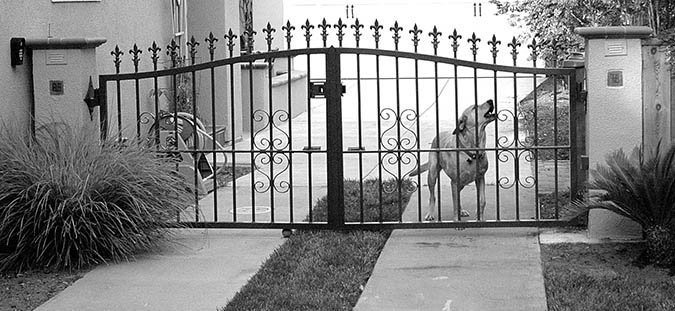
What to Do
Your first step is to gently inform your neighbor that her dog is barking excessively, and when. This is best done during the day, not with an irate phonecall when the dog wakes you up at two o’clock in the morning again. Assume she’s not aware of it, or at least not aware it’s disturbing to her neighbors.
If she seems receptive, show her this article to give her some ideas about how to modify her dog’s barking behavior. If you’re feeling generous, give her a copy of Terry Ryan’s book, The Bark Stops Here, for more in-depth information on barking.
Even if you’ve already had some negative interactions with your neighbor over her dog, it may not be too late to try again, and mend fences. Approach her with an apology for any
past bad words, and let her know you’d like to help with her dog’s barking, if you can. Even short of doing actual behavior modification, offers to let her dog play with yours (if they’re compatible) or taking her dog for walks (if you can safely manage the dog) may enrich the dog’s environment and provide enough exercise to reduce or eliminate the barking.
If she’s not receptive, or if your neighbor is such a threatening presence from the dark side that you’re not comfortable contacting her, you can file a complaint with the animal authorities in your community. Most will not disclose the identity of a complainant, but you should double-check with them to be sure. You may need to make follow-up complaints if their initial contact with the dog owner doesn’t effect an adequate change in behavior.
What NOT to Do
Do not attempt to work with a neighbor’s dog without the permission of the owner. Even with your best of intentions, you could be bitten, you could be sued, and you could actually intensify the bark rather than reducing it. And do not install any electronic anti-barking devices. We are hearing reports that these can be quite aversive, perhaps even painful, for the dogs at which they are directed.
Some Cheese With That Whine?
Dogs do more than just bark. They whine, they whimper, they grumble and growl, they scream, they howl…and each communication can contain messages that help you understand your dog. When your dog is communicating out loud, take a moment to figure out what he’s trying to say, and why, and what, if anything, you should do about it.
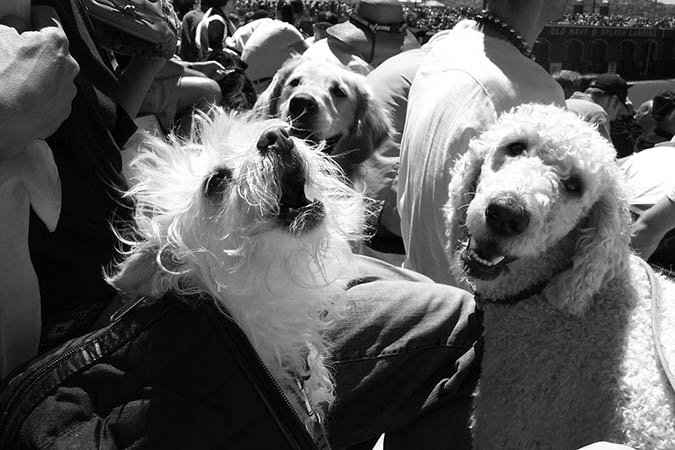
Whines and whimpers are usually related to stress and/or excitment. Some breeds of dogs seem to whine more than others – German Shepherds, for example, seem especially prone to whining. Often this behavior persists because it’s reinforced by the natural human tendency to comfort a whining puppy. Like demand barking, it’s best to ignore whining and reinforce quiet. However, because it’s often stress-induced, if your dog’s a whiner, you might want to evaluate his environment to see if you can reduce the stressors in his world.
Grumbles and growls can have several meanings. Some dogs grumble and growl in enjoyment at a butt-scratch or body massage. More often, a growl is an important warning – “I don’t like you (or whatever you’re doing); please stop!” (See “Understand Why Your Dog Growls,” October 2005.)
Do not punish your dog for this invaluable commmication! It’s the most benign means he has of letting you know that something bothers him. Take away his growl, and a snap or bite is likely to happen without warning. Rather, when your dog growls in warning, step back to see what’s causing him such discomfort, remove the stressor, and figure out how to give him a more positive association with the thing that’s causing the growling.
Aggession is not something to fool around with; seek the help of a professional if your dog is growling at everyday stressors such as children or routine handling. Meanwhile,
count your blessings that your dog has the good sense and inhibition to growl his displeasure rather than sink his teeth into nearby human flesh.
Basenjis are a primitive breed of dog from Africa. They are advertised as “barkless,” but what many people don’t know is that while they don’t bark, they do scream a blood curdling sound that evokes images of a woman being murdered. Except for this unusual breed, most dogs are in extreme stress when they scream. lnvestigate — and rescue.
Who among us hasn’t smiled at our dogs howling at the sound of a fire truck siren speeding past? The howl, which sometimes speaks of a dog’s distress, is also a communal conversation. Dogs often howl in groups, and some owners delight in teaching their dogs to howl on cue, by howling – or singing – themselves. “Group howl” is a popular activity of wild dogs, and of many humans around the campfire at dog camps. Try it – you and your dog might enjoy it!
Teach Your Dog to Bark (and Shush!) on Cue

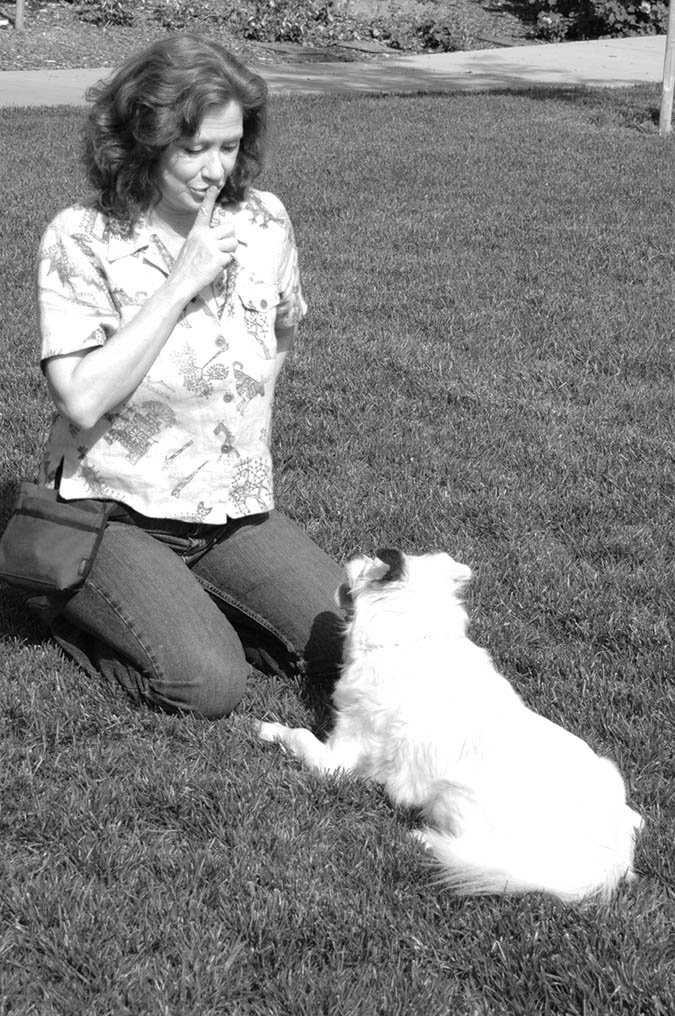
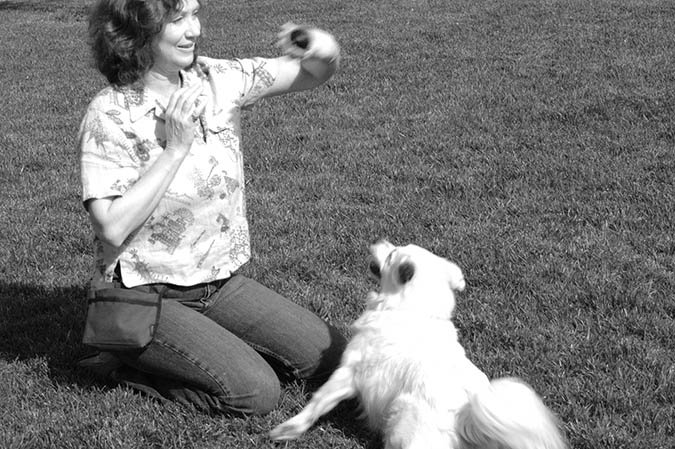
We tend to think of barking as a generally undesirable behavior. ln fact, there may be times when you want your dog to bark. lf you routinely walk or jog with your dog in areas where you might be accosted by unwelcome strangers, a controlled bark from your dog might serve as a useful deterrent. You know your dog is barking on cue, but the potential mugger doesn‘t, and likely assumes your dog‘s willing to back up his bark with a bite.
It may also be easier to teach your dog a “quiet!” cue if you teach him to speak when you ask, rather than just waiting for opportunities to present themselves. To teach him to bark on cue, find a way to trigger a bark. Some dogs will bark if you act silly, tease with a toy, or knock on the door.
Find your dog’s trigger, give your “Speak!” cue, then elicit the bark. (If you want the bark to eventually ward off potential accosters, select a cue that will make sense in that context, such as “Stop!” or “Leave me alone!”)
When your dog barks, mark the desired behavior with the click! of a clicker or a verbal marker, such as the word “Yes!”, and feed him a treat. Repeat this until he’ll bark on just the cue, without the trigger. Then practice in different environments until the “bark on cue” behavior is well generalized. When his “bark on cue” is well established, you can follow it with a “quiet!” cue, so you’ll be able to turn the bark off when you want.
Caveat: Be careful when teaching your dog to bark on cue. Once he learns a bark can make you click! the clicker, he may try demand-barking – and you may get more “speak” than you want. For this reason, I don’t teach my dog to bark on cue unless they already tend to bark too much, in which case it’s useful for teaching “quiet!”
Putting “Speak” on Stimulus Control
You may have heard the suggestion that if you put a behavior such as barking on cue and have it under good stimulus control, the dog then won’t bark unless you give him the cue to speak. Here are the four rules of stimulus control:
1. The dog always offers the behavior when given the cue. (He always barks when you ask him to.)
2. The dog never offers the behavior when you don‘t give him the cue (He never speaks when you don’t ask him to.)
3. The dog never offers the behavior when you cue a different behavior. (He never speaks when you ask him to sit.)
4. The dog never offers a different behavior when you cue the behavior. (He never sits when you ask him to speak.)
It sounds good in theory, perhaps, but in reality, it doesn’t work to stop a behavior. Think about it. Many owners have the “Sit!” cue under good stimulus control – the dog always,
or almost always, sits when asked.
However, that doesn‘t mean the dog never chooses to sit of his own accord. Dogs sit all the time! The above rules apply only during actual training sessions. Having a behavior on cue and under stimulus control does not mean the dog will never choose to do the behavior on his own, or be triggered to offer the behavior by some other stimulus.
In fact, as mentioned above, teaching your dog to bark on cue by reinforcing the behavior makes it more likely your dog will offer to bark, not less. Forewarned is forearmed!
The Positive Interrupt
The positive interrupt is a well-programmed, highly reinforced behavior that allows you to redirect your dog’s attention back to you when she’s doing something inappropriate like barking. Ideally, you want your dog’s response to the “Over here!” cue to be so automatic – classically conditioned – that he doesn’t stop to think whether what he’s doing is more rewarding or interesting than turning his attention toward you and running to you for a treat. He doesn’t think – he just does it, the way your foot automatically hits the brake of your car when you see taillights flash in front of you on the highway.
Here’s how to program a positive interrupt:
1. Install the cue in a low-distraction environment.
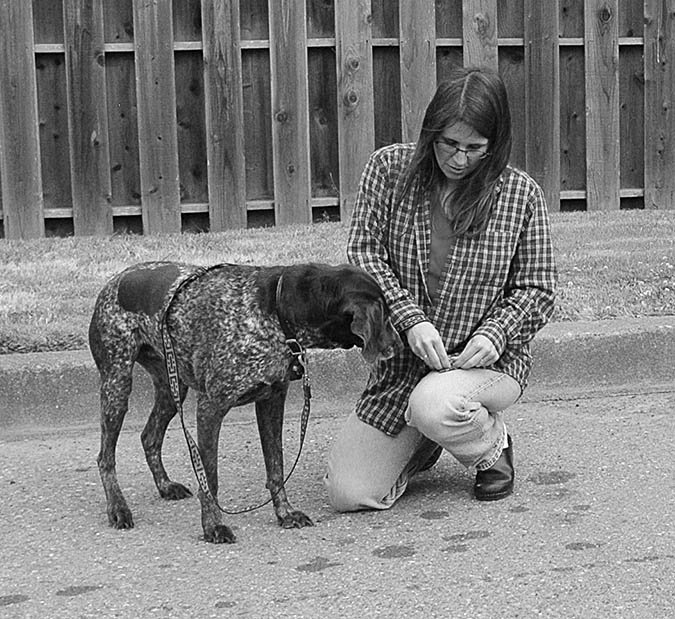
Use a phrase such as “Over here!” or “Quiet please!” as your interrupt cue. Say the phrase in a cheerful tone of voice when your dog is paying attention to you, then immediately feed him a morsel of very high value treat, such as a small shred of chicken. Repeat until you see his eyes light up and his ears perk when you say the phrase.
2. Practice with the cue In a low-distraction environment.
Wait until your dog is engaged in a low-value activity – wandering around the room, sniffing something mildly interesting – then say your interrupt phrase in the same cheerful tone of voice. You should see an immediate interrupt in his low-value activity, as he dashes to you for his chicken. If he doesn’t, return to Step 1.
3. Practice with the cue in a low-distraction environment. Then add distractions.
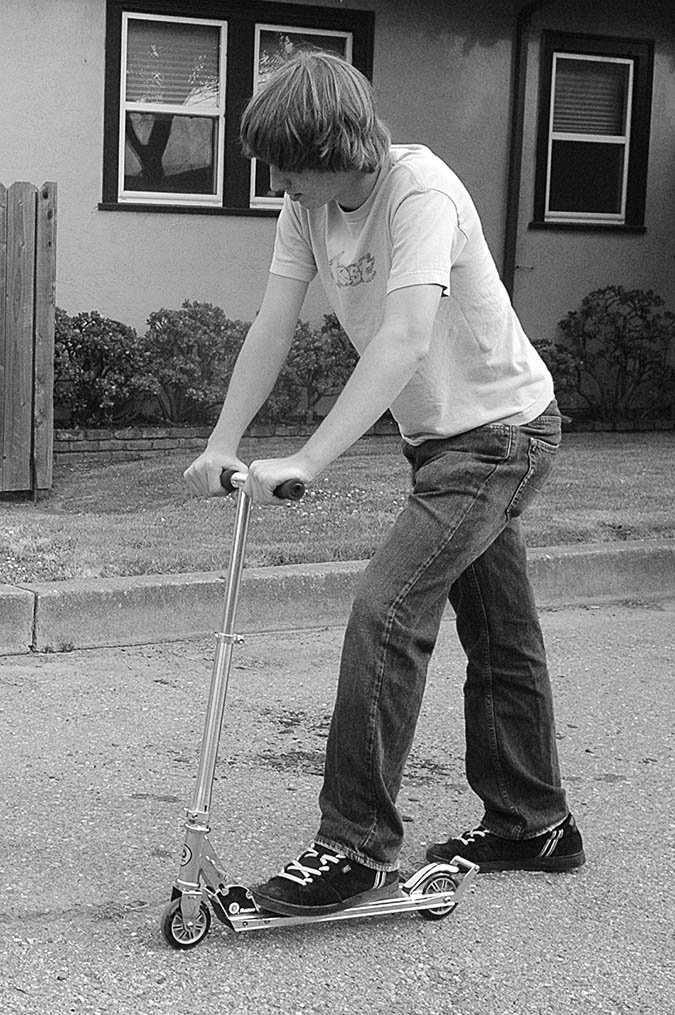
Still in the low-distraction environment, add moderate distractions – one at a time – and practice the interrupt. Gradually move up to major distractions in the low-distraction environment. If you lose his automatic response at any step, return to the previous step.
4. Move your lessons to an environment with real-life distractions.
Go for a walk around the block with your dog on leash. Use the interrupt when he’s sniffing a bush, or eyeing garbage in the gutter. Start with mild to moderate real-life distractions if possible, but if a major distraction presents itself, including a stimulus that causes him to bark, give it a try!
5. Use the positive cue to interrupt barking.
When your dog automatically turns his attention to you in response to your cue when confronted with major real-life distractions, you have a valuable tool for interrupting his barking. Be sure you practice occasionally with mild distractions to keep the cue “tuned up”, and remember to thank him and tell him what a wonderful dog he is when he stops barking on your request.
Pat Miller, CBCC-KA, CPDT-KA, is Whole Dog Journal’s Training Editor. Miller lives in Hagerstown, Maryland, site of her Peaceable Paws training center. She is also the author of, The Power of Positive Dog Training and Positive Perspectives: Love Your Dog, Train Your Dog.



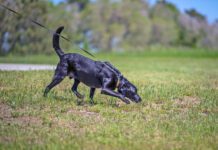



I took my puppy from a dog foster home about a year ago. I love him to bits; he has a great personality, and I feel that he loves our family so much, but he barks A LOT… So, leaving home is always a challenge for us. My husband and I were thinking about taking him to ‘doggy school’, but then again, it’s extremely expensive, and the nearest ‘doggy school’ is far away from us. Maybe you have some advice? THANK YOU!!!
Excellent piece. Thanks!
Are you suggesting that after you us the PI, in any case of unwanted behavior including barking, you then need to use a cue to let your dog know what to do instead of the unwanted behavior? For example, do I need to follow the PI with “quiet”, or are you suggesting the PI is all I need to do to stop the barking. I just want to clarify so not to make things too complicated and confuse my dog.
Thank you Pat, This is one of the most comprehensive articles I have seen on barking. I have 2 Aussies and one our Male definitely lives up to the temperament description suspicious of strangers and a bit bossy. We have nicknamed him the Sheriff because he tries to enforce our house rules on the other pets we have if they are doing things or trying to get into places they are not allowed to go such as our closet. He also will tell people who are misbehaving to knock it off. He listens to me pretty well I get 98% compliance on 1st command, but if my wife asks him to do something not always but if he thinks I may have a different opinion he ignores her and looks at me for permission to do what my wife told him to do. Very intuitive but definitely alert barks like we are under nuclear attack. I have him trained to bark on command but am still trying to get his off switch working. I will come if called but in about 3 – 5seconds will go back to the picture window and continue barking at what is outside. Normally its a delivery truck UPS, FedEx, Post Office, Amazon. or sometimes another dog. I have both him and his sister trained on verbal as well has hand signals for sit, stay, down, stop, come, get collar, roll over clockwise, counter clockwise, spin left/right. Retrieve my cell phone, newspaper from driveway/lawn, shoes from closet, hammer from tool bin, and he helps bring in groceries as well. We dont want to extinguish his bark just need to find off switch. LOL
If the dog is barking its head off and you give it a treat, isn’t it just being rewarded for barking?